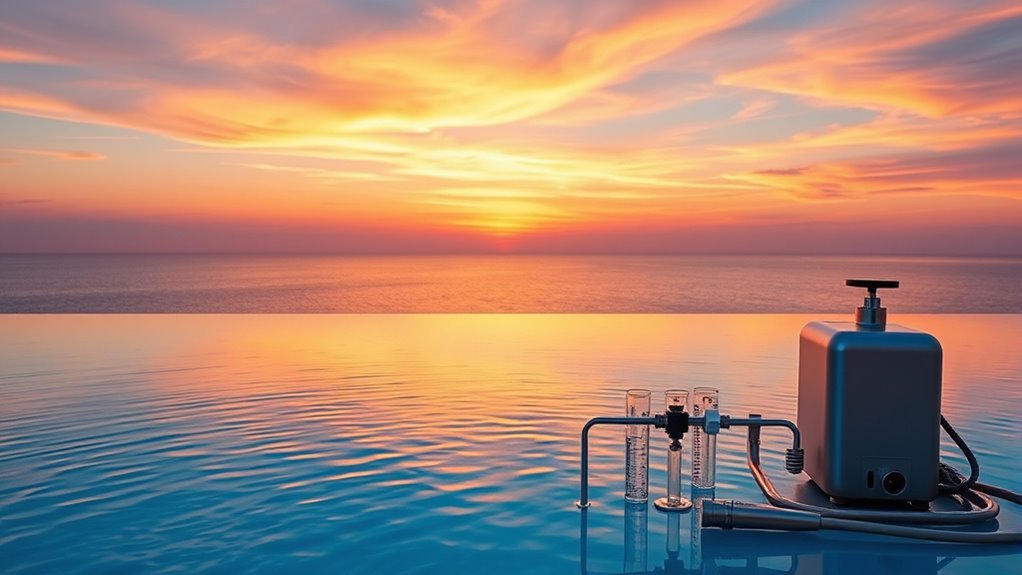To handle chemical balancing in your infinity pool, regularly test your water for pH, alkalinity, chlorine, and calcium hardness using reliable kits. Keep pH between 7.2-7.6 and alkalinity around 80-120 ppm. Adjust chlorine levels to prevent bacteria and algae, and maintain stabilizer at 30-50 ppm. Guarantee proper filtration and circulation, and record your tests and adjustments. If you follow these steps, you’ll learn how to keep your pool water perfectly balanced and inviting.
Key Takeaways
- Regularly test water chemistry (pH, chlorine, alkalinity, calcium hardness) at least twice weekly using reliable test kits.
- Maintain pH between 7.2–7.6 and alkalinity at 80–120 ppm to ensure water stability and swimmer comfort.
- Adjust chlorine levels to stay within recommended ranges, and manage stabilizer (cyanuric acid) at 30–50 ppm.
- Keep filtration systems clean and running 8–12 hours daily to promote proper circulation and prevent chemical imbalances.
- Record all test results and chemical adjustments to monitor trends and respond promptly to imbalances.
Understanding the Importance of Water Chemistry

Understanding the importance of water chemistry is essential for maintaining a safe and balanced infinity pool. Proper chemical balance ensures the water remains clear, clean, and safe for swimmers. When chemicals are out of sync, algae can grow, bacteria can thrive, and your pool’s surfaces may deteriorate faster. You’ll want to keep the pH level balanced, ideally between 7.2 and 7.6, to prevent irritation and protect your equipment. Chlorine or other sanitizers kill harmful germs, so maintaining the right levels is vital. Additionally, alkalinity buffers pH fluctuations, helping stabilize the water. Ignoring water chemistry can lead to cloudy water, foul odors, and costly repairs. Regularly understanding and managing your pool’s chemistry keeps your infinity pool inviting, safe, and beautiful for everyone who dips in. Proper testing and adjustment of water chemistry parameters are crucial for long-term pool health.
Testing Your Pool Water Regularly
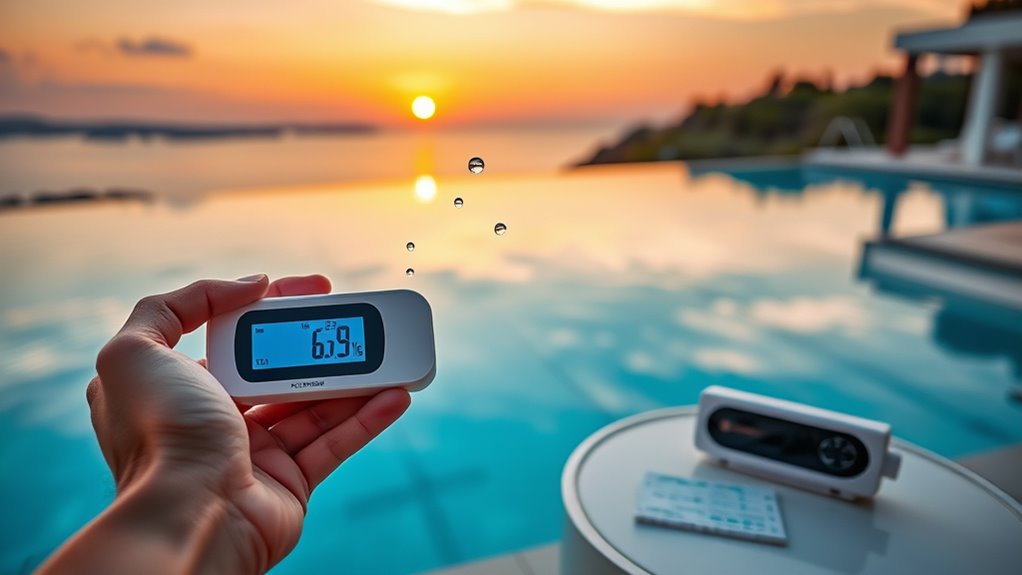
Regularly testing your pool water is essential for maintaining proper chemical balance and ensuring safety. By checking your water frequently, you can catch imbalances early before they become bigger problems. Use reliable test kits or digital testers to measure pH, chlorine levels, and other chemicals. Aim to test at least twice a week, especially during hot weather or heavy use, when chemical levels can fluctuate quickly. Record your results to track trends and identify patterns. If tests reveal imbalances, adjust chemicals promptly to restore proper levels. Consistent testing helps prevent issues like algae growth, cloudy water, or skin irritation. Monitoring your water’s chemical levels regularly allows you to maintain a safe and inviting infinity pool environment. Staying proactive with regular testing ensures your infinity pool remains safe, clean, and inviting for every swim.
Maintaining Proper Ph Levels
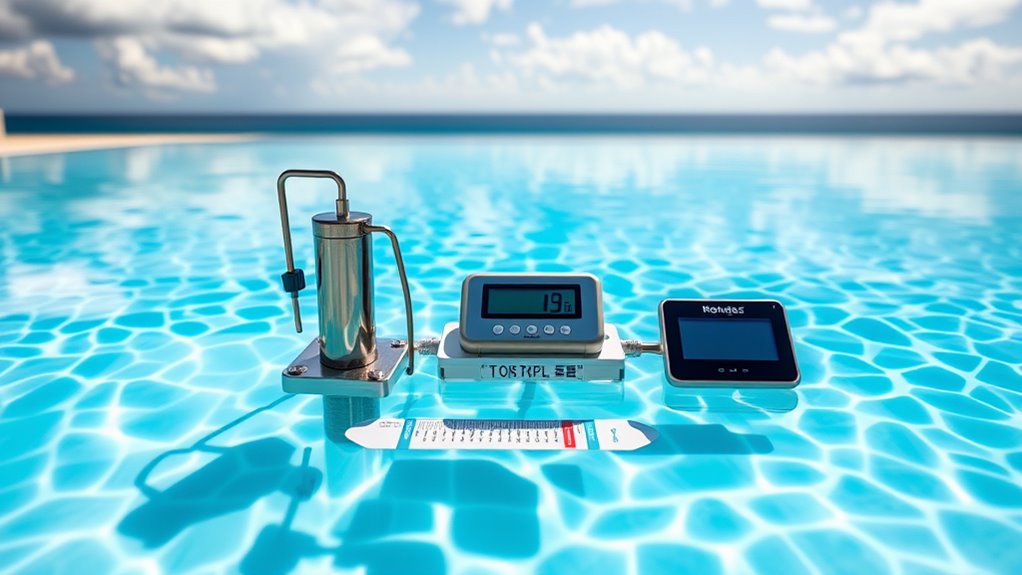
Maintaining proper pH levels is essential for keeping your infinity pool safe and comfortable. When pH is too high, algae growth and cloudy water can occur, while low pH can cause skin irritation and damage pool equipment. You should test your water regularly, ideally at least twice a week, to monitor pH levels. The ideal range is between 7.2 and 7.6. If your pH is off, add pH increasers or decreasers as needed. Always follow manufacturer instructions carefully to avoid overcorrection. Proper pH balance also helps other chemicals work effectively, reducing the need for frequent adjustments. Consistent testing and adjustments will ensure your pool remains inviting, safe, and well-maintained for everyone enjoying the infinity view. Regularly tracking chemical levels using reliable methods helps maintain overall water quality and prevents issues before they escalate.
Adjusting Alkalinity for Stability
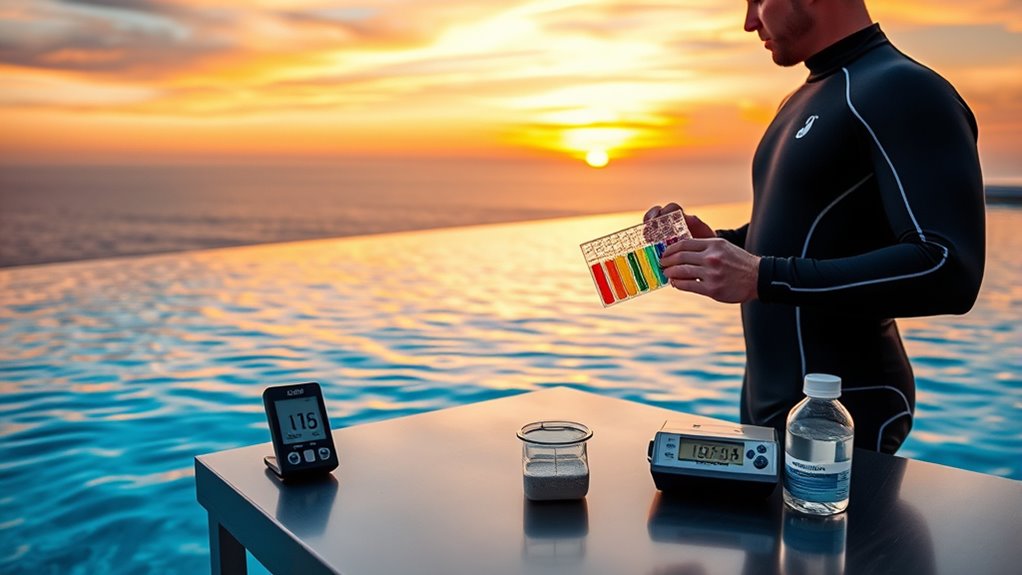
Once you’ve adjusted your pool’s pH to stay within the proper range, it’s time to focus on alkalinity, which acts as a buffer to keep pH stable. You want your alkalinity levels between 80 and 120 ppm. If alkalinity is too low, pH can fluctuate rapidly, causing instability. To raise alkalinity, add a sodium bicarbonate (baking soda) solution gradually, distributing it evenly around the pool while the pump runs. Test frequently to avoid overshooting your target. If alkalinity is too high, it can lead to cloudy water and scaling. In that case, you’ll need to add a pH reducer, such as muriatic acid, carefully following the instructions. Maintaining proper alkalinity guarantees your pool’s water remains balanced and prevents pH swings. Proper alkalinity levels are essential for maintaining overall water stability and preventing corrosion or scaling.
Managing Chlorine Levels Effectively
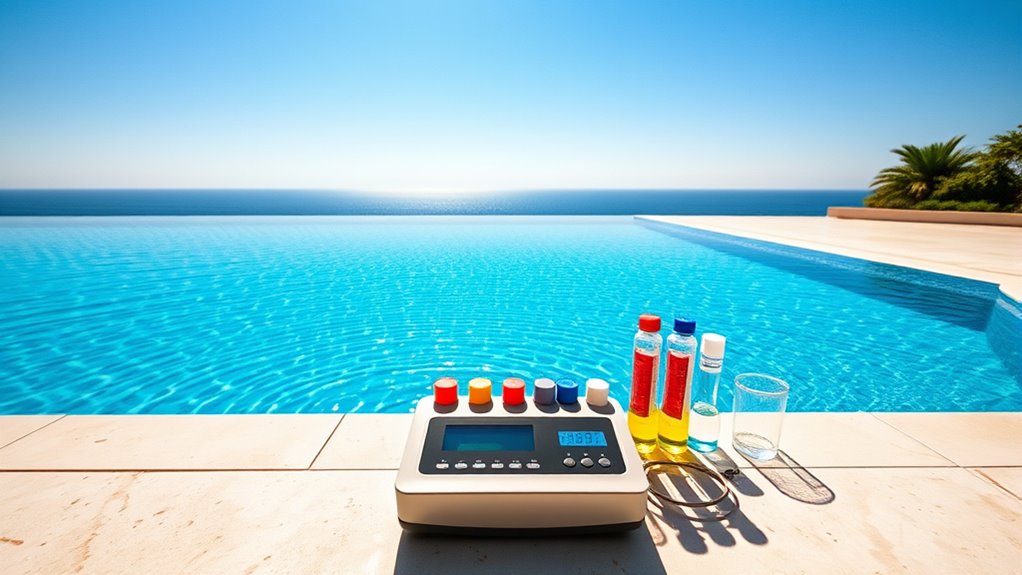
How can you guarantee your infinity pool’s water stays safe and clean? Managing chlorine levels is key. You need to maintain the right balance to prevent bacteria growth and algae without over-chlorinating, which can cause irritation. Test your water regularly using a reliable test kit or strips. Adjust chlorine levels as needed—adding tablets, liquid, or using a chlorinator system. Keep an eye on weather conditions, as heat and sunlight can deplete chlorine faster. Proper circulation ensures even distribution. Also, avoid shocking the pool excessively, as it can increase chlorine demand. Consistent maintenance helps keep your pool inviting and safe. Incorporating regular testing, along with monitoring environmental factors, is essential for optimal water quality.
Controlling Cyanuric Acid and Stabilizer Levels
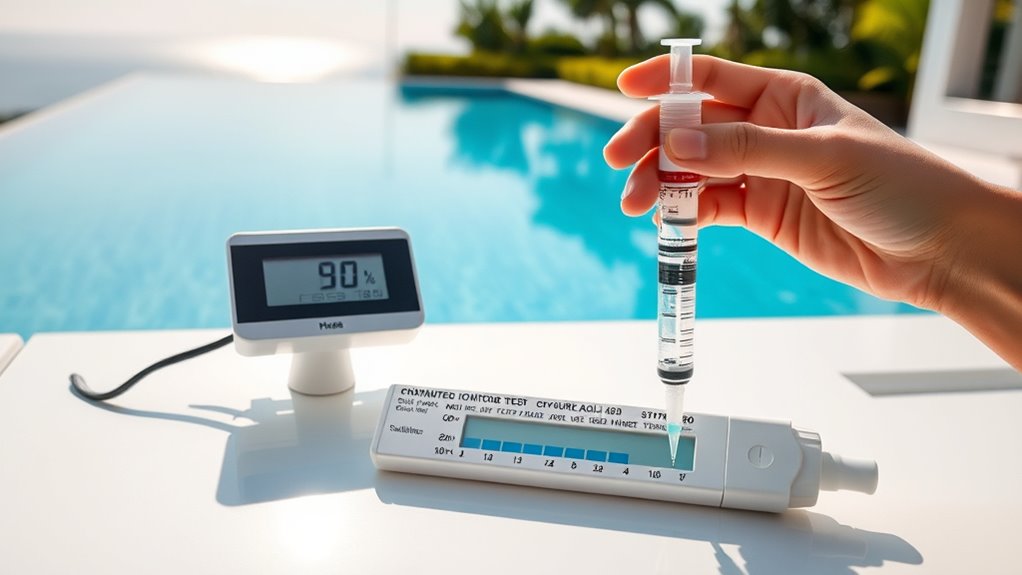
You need to keep a close eye on your cyanuric acid levels to prevent them from getting too high or too low. Adjust your stabilizer concentration accordingly to maintain the right balance. Proper monitoring and adjustments help keep your pool water safe and clear. Regular testing and understanding chemical balance are essential for effective pool maintenance.
Monitoring Cyanuric Acid Levels
Have you checked your cyanuric acid levels lately? Regular monitoring helps prevent imbalances that can compromise your pool’s water quality. Use a reliable test kit or digital meter designed for cyanuric acid measurement to get accurate readings. Keep a record of your results to track trends over time. Remember, ideal cyanuric acid levels typically range from 30 to 50 ppm for an infinity pool. If levels are too high, it can reduce chlorine effectiveness; if too low, your stabilizer won’t protect chlorine from UV degradation. Consistently checking your cyanuric acid guarantees you can make informed adjustments quickly, maintaining water clarity and safety. Regular water quality assessments are essential for optimal pool performance.
- Use precise testing methods regularly
- Record and track your readings
- Maintain levels within recommended range
Adjusting Stabilizer Concentration
Controlling cyanuric acid and stabilizer levels requires proactive adjustments to maintain ideal water quality in your infinity pool. If stabilizer levels are too high, chlorine becomes less effective, so you need to dilute the water with fresh, unstabilized water or perform partial draining and refilling. Conversely, if stabilizer levels are too low, your chlorine will degrade quickly, reducing its disinfectant power. To increase stabilizer, add cyanuric acid directly to the water, following manufacturer instructions for proper dosing. Regular testing with a reliable test kit helps you track levels and make timely adjustments. Keep stabilizer levels within the recommended range of 30-50 ppm. Consistent monitoring and adjustments ensure your pool stays balanced, safe, and crystal clear.
Monitoring and Regulating Calcium Hardness
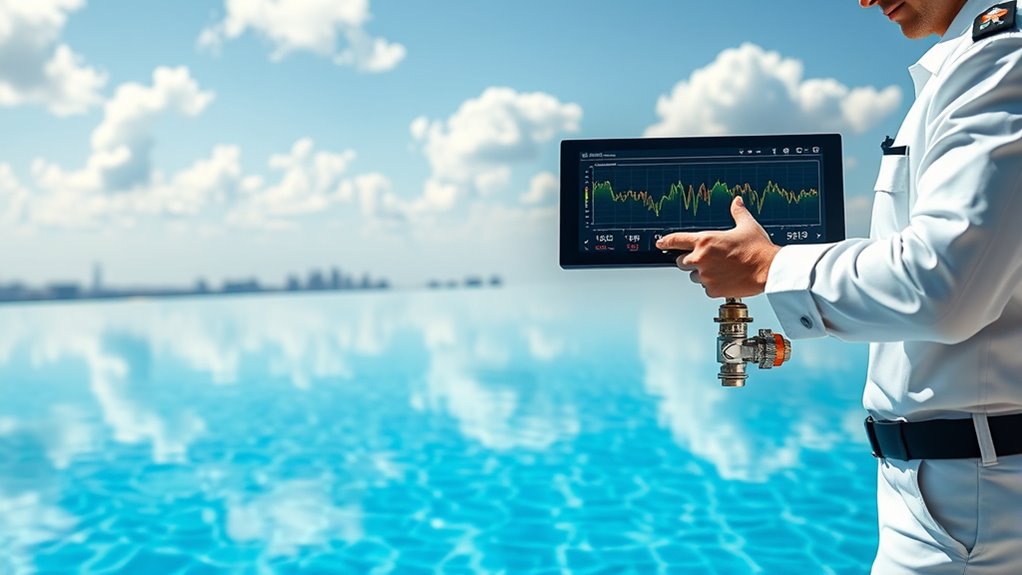
Ever wondered how to keep calcium hardness levels in check in an infinity pool? Maintaining proper calcium hardness prevents scaling, cloudy water, and equipment damage. Regular testing is essential—use a reliable test kit weekly to monitor levels. If calcium hardness is too low, add a calcium increaser to strengthen water stability. Conversely, if levels are too high, dilute the water with fresh supply or use chemical treatments to reduce calcium buildup. Keep an eye on pH and alkalinity, as they influence calcium stability. Proper regulation ensures your pool water remains clear, balanced, and safe for swimmers.
- Regularly test calcium hardness levels
- Add calcium increaser or reducer as needed
- Maintain balanced pH and alkalinity for stability
Preventing and Addressing Algae Growth

To keep algae at bay, you need to check your chlorine levels regularly and make certain they’re within the recommended range. Proper filtration maintenance is essential to prevent algae spores from settling and multiplying. Staying vigilant with these steps helps keep your infinity pool clear and algae-free. Additionally, maintaining appropriate chemical balance reduces the likelihood of algae growth and promotes a healthier swimming environment.
Regular Chlorine Checks
Regular chlorine checks are essential to keep your infinity pool clear and prevent algae from taking hold. By testing chlorine levels frequently, you ensure the water remains sanitized and algae growth stays at bay. If chlorine levels fall below the recommended range, algae can quickly flourish, turning your pool green and cloudy. Consistent checks allow you to catch issues early and adjust chlorine dosage accordingly. Remember, maintaining proper chlorine levels also supports other chemical balances in your pool. Regular testing is especially important because chemical imbalance can lead to other water quality issues if not addressed promptly.
- Test chlorine levels at least twice a week
- Use reliable test kits for accurate readings
- Adjust chlorine doses promptly if levels are low
Keeping a regular testing schedule helps you maintain clean, inviting water and reduces the risk of algae-related problems.
Proper Filtration Maintenance
Proper filtration maintenance is crucial for preventing and addressing algae growth in your infinity pool. Regularly clean and inspect your filter to guarantee it’s functioning properly. A dirty or clogged filter reduces water flow, creating stagnant areas where algae can thrive. Backwash or replace filters as needed, following the manufacturer’s instructions. Run your filtration system daily for at least 8-12 hours, especially during warm weather, to keep water circulating and prevent algae buildup. Keep an eye on pressure gauges; a rise indicates a dirty filter that needs attention. Additionally, ensure your pool’s skimmers and pump baskets are clean, removing debris that could hinder filtration. Consistent maintenance helps maintain water clarity and reduces the likelihood of algae growth, keeping your infinity pool pristine.
Properly Circulating and Filtering Water

Ensuring water in your infinity pool circulates and filters effectively is essential for maintaining clarity and safety. Proper circulation prevents stagnation and distributes chemicals evenly, reducing algae and bacteria growth. Make sure your pump runs long enough each day to keep water moving consistently. Regularly check and clean your filter to guarantee it’s free of debris and functioning properly. Proper filtration captures dirt, oils, and other contaminants, keeping your water clear and balanced. Additionally, consistent maintenance and appreciation of the father-daughter bond can serve as a reminder to nurture the relationship while caring for your pool.
Establishing a Routine Maintenance Schedule

To keep your infinity pool in top condition, establishing a routine maintenance schedule is essential. Regular checks help you maintain proper chemical balance, clarity, and safety. Start by testing your water weekly for pH, chlorine, alkalinity, and stabilizer levels. Adjust chemicals promptly to prevent imbalances. Clean the skimmer and filter baskets weekly to ensure efficient filtration. Brush the pool walls and vacuum the bottom once a month to remove dirt and algae buildup. Inspect the pump and filter system regularly for leaks or wear. Keep detailed records of your maintenance activities and chemical adjustments. Consistency prevents issues before they escalate, saving you time and money. A well-planned routine keeps your infinity pool inviting, safe, and beautifully balanced year-round.
Frequently Asked Questions
How Does the Unique Environment of an Infinity Pool Affect Chemical Balance?
The unique environment of an infinity pool impacts chemical balance by exposing it to more sunlight, wind, and debris, which can cause faster chemical fluctuations. You need to regularly test and adjust pH, alkalinity, and sanitizer levels to maintain clarity and safety. Since water flows over the edge, chemicals can be lost more quickly, so frequent topping up and balancing are essential to keep the water pristine and safe for swimmers.
Are There Specific Chemicals Recommended for Maintaining Infinity Pool Water?
Yes, there are specific chemicals you should use to keep your infinity pool crystal clear. You’ll primarily need chlorine or bromine to disinfect, pH adjusters to control acidity, and algaecides to prevent algae growth. But be cautious—using the wrong chemicals or incorrect amounts can upset the delicate balance, risking cloudy water or damage. Stay vigilant, follow recommended guidelines, and test your water regularly to make sure it remains perfectly balanced.
How Often Should Chemical Levels Be Checked in an Infinity Pool?
You should check your infinity pool’s chemical levels at least 2 to 3 times a week, especially during peak use or hot weather. Regular testing helps you maintain proper pH, chlorine, and alkalinity levels, preventing algae growth and ensuring safe swimming conditions. Use a reliable test kit or digital tester, and adjust chemicals as needed. Consistent monitoring keeps your pool balanced and inviting for everyone.
Can Water Temperature Influence Chemical Stability in Infinity Pools?
You might not realize it, but water temperature can secretly influence your infinity pool’s chemical stability. As temperatures rise, chemicals dissolve faster and can become less effective, leading to imbalances. Cooler water slows reactions, giving you more control. Keep a close eye on temperature fluctuations, especially during hot summer days or chilly nights, because ignoring this subtle factor could turn your pristine pool into a chemical mystery you can’t solve without proper adjustments.
What Are Common Mistakes in Chemical Balancing Specific to Infinity Pools?
You often make mistakes like overusing chlorine, which can cause cloudiness and skin irritation, or neglecting regular testing, leading to imbalanced pH levels. You might also ignore the unique spillover design, causing uneven chemical distribution. Additionally, skipping proper filtration or not adjusting chemicals after heavy rain can compromise water quality. To avoid these issues, stay consistent with testing, calibrate your chemicals carefully, and monitor the pool frequently.
Conclusion
Mastering chemical balancing in your infinity pool is like wielding the power to create a crystal-clear oasis that sparkles like a million diamonds under the sun. With diligent testing, precise adjustments, and routine maintenance, you’ll turn your pool into a flawless paradise so pristine, even mermaids would envy it. Keep up the effort, and you’ll have a shimmering, balanced haven that transforms every swim into an extraordinary, almost magical experience!
